SEDE VACANTE
1846
June 1, 1846—June 16, 1846
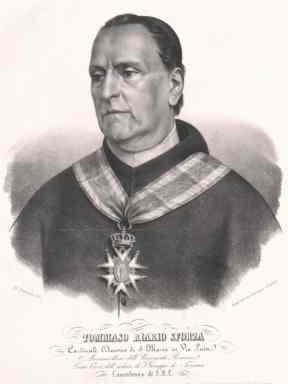
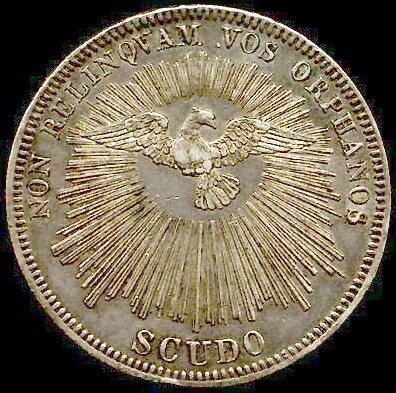 |
AG |
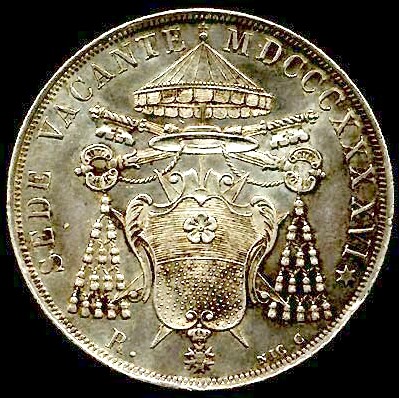 |
SEDE VACANTE MDCCCXLVI Arms of Tommaso Cardinal Riario Sforza, Camerlengo of the Holy Roman Church, surmounted by the Ombrellone, crossed keys, and the Cardinal's Hat with fifteen tassels on each side. Mint of Bologna Berman, p. 209 #3295. |
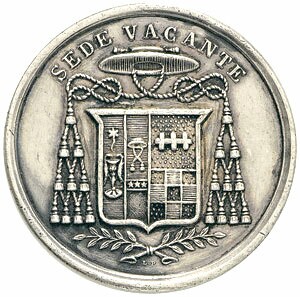 |
AE SEDE VACANTE The Arms of Msgr. Alerame Pallavicini, surmounted by an episcopal hat, ten tassels on each side, crossed laurel branches beneath. |
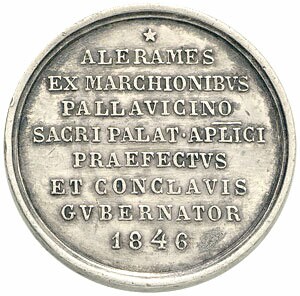 |
|
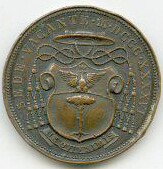 |
AE SEDE VACANTE MDCCCXXXXVI The Arms of Msgr. Pietro Marini, surmounted by an episcopal hat, ten tassels on each side.. |
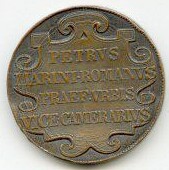 |
PETRVS | MARINI•ROMANVS | PRAEF•VRBIS | VICE·CAMERARIVS |
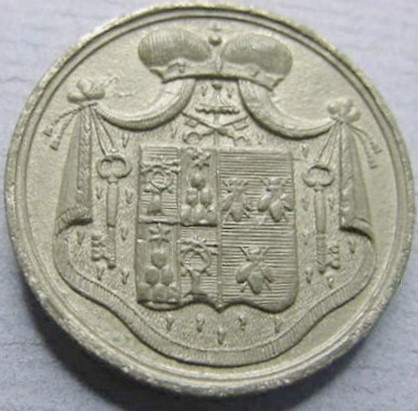 |
AE The Arms of Prince Agostino Chigi, surmounted by crossed keys and the Ombrellone, a princely crown above and drapery with two keys.. |
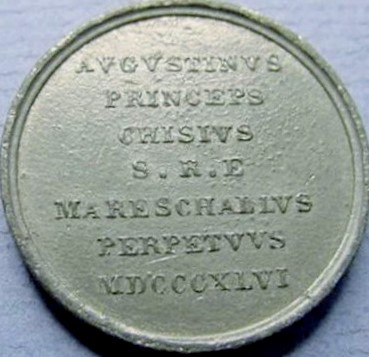 |
|
CAMERLENGO
TOMMASO CARDINAL RIARIO SFORZA (1782-1857), Patrician of Naples, was born at Naples, the tenth child and youngest son of Nicola Riario Sforza, third Duca Riario Sforza, sixth Marchese di Corleto, etc.; and Giovanna di Somma, daughter of Don Gennaro, seventh Principe del Colle, eighth Marchese di Circello. Tommaso was named Governor of the papal territory of Macerata in 1814. In 1816 he became Prefect of the Papal Household. He was created Cardinal Deacon of S. Giorgio in Velabro on March 10, 1823, and finally ordained priest on September 28 at the age of 41. As a cardinal he participated in the Conclaves of 1823, 1829, 1831 and 1846. In January 1843 he became Prefect of the Congregation on Good Government. He was named Camerlengo of the Holy Roman Church on April 3, 1843, a post which he held until his death on March 14, 1857. [His medal: Mazio #915]The Dean of the College of Cardinals was Cardinal Luigi Micara. He had been created a cardinal by Leo XII in pectore in December of 1824, and was proclaimed on March 13, 1826. He was assigned the titular church of SS. Quattro Coronati. He served as Prefect of the SC of Rites, and as Prefect of the SC of Ceremonies. Prefect of the Supreme Council of the Apostolic Camera. In 1837 he was promoted to be Suburbicarian Bishop of Frascati, and in 1844 to be Dean of the Sacred College and Suburbicarian Bishop of Ostia e Velletri. He died on May 24, 1847. After his death, Massimo d'Azeglio wrote (from Rome, May 28, 1847), "C' était un homme intègre, à formes un peu dures, qui s'était acquis une grande popularité à l'époque de la sede vacante, pour avoir vertement tancé le cardinal Lambruschini pour le nombre de créatures qu'il s'était faites aux frais de l'État, le cardinal Bernetti pour l'affaire des Suisses, et le cardinal Tosti pour ses dilapidations." (Bianchi, p. 8 n. 7)
The Governor of the Conclave was Msgr. Alerame Pallavicini, Maggiordomo de' Sacri Palazzi Apostolici.
The Marshal of the Conclave was Prince Agostino Chigi, Mareschallus Perpetuus Sanctae Romanae Ecclesiae
Death of Gregory XVI
Pope Gregory XVI died on June 1, at 9:15 a.m., according to Prince Chigi (Diario del Principe Don Agostino Chigi [Tolentino 1906], 175): "Il Papa ieri cominciò a peggiorare fortissimamente, essendosegli caricato il petto, ed il tracollo è andato precipitosamente sempre crescendo nella notte, talmente che questa mattina alle 13,15 italiane (ossia 9,15 di Francia) è passato all' altra vita." He had been ill for some eight days. On the morning of June 1, he received Extreme Unction at the hands of Father Agostino Proja, the sub-Sacristan, while Cardinal Castracani degli Antelminelli, the Major Penitentiary, recited the prayers for the dying. The Secretary of State, Cardinal Lambruschini, Bishop of Sabina, was present. Cardinal Patrizi, the Vicar for Rome, had ordered the recitation of the customary prayers in all the churches of the city.
He had lived eighty years, eight months and fourteen days, and had reigned for 15 years, three months and twenty-nine days. In those fifteen years, he had created seventy-five cardinals.
Upon the death of the Pope, the Cardinal Chamberlain, Cardinal Riario-Sforza was informed. He summoned the clerics of the Apostolic Camera and repaired to the Apostolic Palace of the Vatican [Descrizione veridica.del Conclave e delle Cerimonie (Milano 1846), 99-100, quoted from Diario Romano of June 2, 4, and 6, 1846]
Entrata l' Em. S. nella camera, dove questo [Gregorio XVI] giacea, prostrato in terra e fatta la preghiera, lo asperse coll'acqua santa. Indi si appressò al letto, nel tempo stesso che venne scoperto il volto di Sua Santità. Tornò allora l'Em. Cardinali a' piedi dell letto, ed ivi recitò il salmo De profundis con la sua orazione. Quindi dal Notaro Segretario di Camera, genuflesso, si lesse il rogito della ricognizione e della consegna dell' anello Piscatorio, che fu rimesso in mani della sullodata Em. Sua da Monsig. Medici d'Ottajano Maestro di Camera del trapassato Pontefice. Passò di poi Sua Emin. in una delle grandi sale dell'appartamento pontificio ed ordinò che si suonasse la gran campana del Campidoglio, onde annunciare, guista il costume, al popolo romano la vacanza della Sede Apostolica.
On the evening of June 1, Cardinal Micara, the Dean of the Sacred College of Cardinals, presided at a meeting of the Cardinals. Cardinal Riario-Sforza, who was both Camerlengo and Protodeacon, was present, along with Cardinal Fransoni, the Protopriest. The Secretary of the Sacred College, Msgr. Corboli-Bussi, was in attendance.
On the morning of June 2, the papal corpse, which had been eviscerated and enbalmed, was carried to the Sistine Chapel. In the evening, the viscera of the pope were transported in a gaudy procession to the Church of SS. Vincenzo ed Anastasio, the parish church of the Quirinale Palace, where they were entombed in the crypt.
The First General Congregation of the Cardinals was held at the Vatican Palace on the morning of June 4. The various Constitutions of popes governing the holding of conclaves were read, and each of the cardinals present swore their obedience. The Fisherman's Ring was defaced and the seals broken. Monsignor Pietro Marini was confirmed as Governor of Rome. After the meeting, the Cardinals participated in the removal of the body of the deceased Pope to the Chapel of the Blessed Sacrament in S. Peter's Basilica, where Msgr. Tanara, the titular Patriarch of Antioch and Canon of St. Peter's, performed the ceremony of Absolution.
The Cardinals
A list of the Cardinals who participated in the Conclave is given in Descrizione veridica.del Conclave e delle Cerimonie (Milano 1846), pp. 19-21 Coronation is given in L' ami de la réligion, p. 29. Cardinal Giacomo Monico, the Patriarch of Venice had arrived by then. The name of Cardinals Mai and Bernetti are omitted. Bernetti's gout was well-known.
- Luigi Micara (aged 71), OFM Cap [Frascati]. Suburbicarian Bishop of Ostia e Velletri (died May 24, 1847). Dean of the Sacred College of Cardinals.
- Vicenzo Macchi (aged 75), [Capodimonte, diocese of Montefiascone]. Suburbicarian Bishop of Porto e Santa Rufina. Prefect of the Signature of Justice. Secretary of the SC of the Holy Office. S.R.E. Bibliothecarius. (died September 30, 1860).
- Luigi Lambruschini (aged 70) [Genoa], Suburbicarian Bishop of Sabina. Secretary of State of Gregory XVI. Abate of S. Maria di Farfa. Grand Prior in Rome of the Knights of St. John of Jerusalem (died May 12, 1854).
- Pietro Ostini (aged 71) [Roma], Suburbicarian Bishop of Albano. Prefect of the SC of Bishops and Regulars. (died April 4, 1849).
- Castruccio Castracane degli Antelminelli (aged 66) [Perugia], Suburbicarian Bishop of Palestrina. Major Penitentiary. (died February 22, 1852).
- Mario Mattei (aged 53) [Pergola], Suburbicarian Bishop of Frascati (died October 7, 1870), Archpriest of the Vatican Basilica. Secretary for Internal Affairs.
- Carlo Oppizzoni (aged 77) [Milano], Cardinal Priest of S. Lorenzo in Lucina (died April 13, 1855). Archbishop of Bologna (1802-1855).
- Giacomo Filippo Fransoni (aged 70) [Genoa], Cardinal Priest of S. Maria in Ara Coeli. (died April 20, 1856) Prefect of the SC de propaganda fide.
- Benedetto Colonna Barberini di Sciarra (aged 57) [Roma], Cardinal Priest of S. Maria in Trastevere (died April 10 1863). Archpriest of the Lateran Basilica. Prefect of the SC of the Immunità (a congregation founded on June 22, 1622, by Urban VIII, taking over tasks previously dealt with by the SC on Bishops founded by Sixtus V on January 22, 1588).
- Francesco Serra-Cassano (aged 63) [Naples], Cardinal Priest of Ss. XII Apostoli (died August 17, 1850). Archbishop of Capua (1826-1850).
- Ugo Pietro Spinola (aged 55) [Genoa], Cardinal Priest of S. Martino ai Monti (died January 21, 1858) Pro-Datary of Gregory XVI .
- Luigi Brignole (aged 49) [Genoa], Cardinal Priest of S. Cecilia (died June 23, 1853).
- Costantinio Patrizi Naro (aged 47) [Romanus, born in Siena], Cardinal Priest of S. Silvestro in Capite (died December 17, 1876). Vicar-General of Rome, Archpriest of the Liberian Basilica (S. Maria Maggiore) [V. Forcella, Inscrizioni delle chiese di Roma 9, p. 356, no.738]. Prefect of the SC of the Residence of Bishops.
- Giuseppe Alberghini (aged 75) [Bononiensis], Cardinal Priest of S. Prisca (died September 30, 1847).
- Paolo Polidori (aged 68) [Jesi], Cardinal Priest of S. Prassede (died April 23, 1847). Abbate commendatorio ed ordinario of Subiaco. Prefect of the SC of the Council.
- Ambrogio Bianchi, OSB Cam.(aged 74) [Cremona], Cardinal Priest of SS. Andrea e Gregorio al Monte Celio (died March 3, 1856). Former Prior-General of the Camaldolese Congregation. Prefect of the SC of the Discipline of Regulars.
- Gabriele Della Genga Sermattei (aged 45) [Assisi], Cardinal Priest of S. Girolamo dei Croati (died February 10, 1861). Legate in Urbino and Pesaro (not Pisa).
- Luigi Amat di San Filippo e Sorso (aged 50) [Cagliari], Cardinal Priest of S. Maria in Via (died March 30, 1878). Legate in Ravenna.
- Angelo Mai (aged 64) [Schilpario, diocese of Bergamo], Cardinal Priest of S. Anastasia (died September 9, 1854). Prefect of the S.C. of the Index. Protector of the Order of Preachers (Dominicans).
- Giovanni Soglia Ceroni (aged 66) [Casola Valsenio, diocese of Imola], Cardinal Priest of SS. Quattro Coronati (died August 12, 1856). Bishop of Osimo (1839-1856).
- Chiarissimo Falconnieri-Mellini (aged 51) [Romanus], Cardinal Priest of S. Marcello (died August 22, 1859). Archbishop of Ravenna (1826-1859).
- Antonio Francesco Orioli, OFM Conv. (aged 67) [Bagnacavallo, diocese of Faenza], Cardinal Priest of S. Maria sopra Minerva (died February 20, 1852). Protector of the OFM.Conv.
- Antonio Tosti (aged 69) [Romanus], Cardinal Priest of S. Pietro in Montorio (died March 20, 1866).
- Giuseppe Mezzofanti (aged 71) [Bologna], Cardinal Priest of S. Onofrio (died March 15, 1849). Protector of the Carmelites.
- Filippo De Angelis (aged 54) [Ascoli], Cardinal Priest of S. Bernardo alle Terme (died July 8, 1877). Archbishop of Fermo (1842- ).
- Gabriele Ferretti (51) [Ancona], Cardinal Priest of SS. Quirico e Giulitta (died September 13, 1860) . Prefect of the SC of Indulgences and Sacred Relics.
- Charles Acton (aged 43) [Naples], Cardinal Priest of S. Maria della Pace (died June 23, 1847). Protector of the OFM.Cap.
- Ferdinando Maria Pignatelli (aged 76) [Naples], Cardinal Priest of S. Maria della Vittoria (died April 10, 1853). Archbishop of Palermo.
- Giovanni Maria Mastai-Ferretti (aged 54) [Sinigaglia], Cardinal Priest of Ss. Marcellino e Pietro (died February 7, 1878). Archbishop-Bishop of Imola (1832-1846).
- Gaspare Bernardo Pianetti (aged 66) [Jesi], Cardinal Priest of S. Sisto (died January 30, 1862). Bishop of Viterbo and Toscanella.
- Luigi Vannicelli-Casoni (aged 45) [Amelia], Cardinal Priest of S. Callisto (died April 21, 1877).Legate in Bologna.
- Lodovico Altieri (aged 40) [Romanus], Cardinal Priest of S. Maria in Portico (died August 11, 1867).
- Tommaso Gizzi (aged 58) [Ceccano, diocese of Ferentino], Cardinal Priest of S. Pudenziana (died June 3, 1849). Legate in Forlì.
- Cosimo Corsi (aged 48) [Florentinus], Cardinal Priest of Ss. Giovanni e Paolo (died October 7, 1870) Bishop of Jesi.
- Antonio Maria Cadolini (aged 75) [Ancona], Cardinal Priest of S. Clemente (died August 1, 1851). Bishop of Ancona.
- Fabio Maria Asquini (aged 33) [Udine], Cardinal Priest of S. Stefano al Monte Celio (died December 22, 1878).
- Antonio Maria Cagiano de Azevedo (aged 48) [diocese of Aquino], Cardinal Priest of S. Croce in Gerusalemme (died January 13, 1867). Bishop of Senigaglia (1844-1851).
- Nicola Clarelli Parracciani (aged 47) [Rieti], Cardinal Priest of S. Pietro in Vincoli (died July 7, 1872). Bishop of Montefiascone and Corneto (1844-1854).
- Domenico Caraffa di Traetto (aged 40) [Naples], Cardinal Priest of S. Maria degli Angeli (died June 17, 1879). Archbishop of Benevento (1844- ).
- Lorenzo Simonetti (aged 57) [Roma], Cardinal Priest of S. Lorenzo in Panisperna (died January 9, 1855).
- Giacomo Piccolomini (aged 50) [Siena], Cardinal Priest of S. Balbina (died August 17, 1861) .
- Sisto Riario Sforza (aged 35) [Naples], Cardinal Priest of S. Sabina (died September 29, 1877). Archbishop of Naples.
- Tommaso Riario Sforza (aged 64) [Naples], Cardinal Deacon of S. Maria in Via Lata (died March 14, 1857). Arch-Chancellor of the University of Rome
- Tommaso Bernetti (aged 66) [Fermo], Cardinal Deacon of S. Lorenzo in Damaso (died March 21, 1852). Vice-Chancellor S.R.E., Sommista of Apostolic Letters.
- Ludovico Gazzoli (aged 72) [Terni], Cardinal Deacon of S. Eustachio (died February 12, 1858). Prefect of the SC of "Good Government".
- Adriano Fieschi (aged 58) [Genoa], Cardinal Deacon of S. Maria ad Martyres (died February 6, 1858).
- Luigi Ciacchi (aged 80) [Pesaro], Cardinal Deacon of S. Angelo in Pescheria (died December 17, 1865)).
- Giuseppe Ugolini (aged 63) [Macerata], Cardinal Deacon of S. Adriano al Foro. Legate in Ferrara. (died December 19, 1867).
- Francesco Saverio Massimo (aged 40) [Romanus], Cardinal Deacon of S. Maria in Domnica. Legate in Ravenna. (January 11, 1848).
- Giovanni Serafini (aged 59) [Magliano], Cardinal Deacon of S. Maria in Cosmedin (died February 1, 1855).
- Karl Kajetan Gaisruck (aged 76) [Klangenfurt, diocese of Gürk], Cardinal Priest of S. Marco (died November 19, 1846). Archbishop of Milan (1818-1846).
- Francisco Javier de Cienfuegos y Jovellanos (aged 70) [Oviedo], Cardinal Priest of S. Maria del Popolo (died June 21, 1847) Archbishop of Seville (1825-1847).
- Giacomo Monico (aged 69) [Riese, diocese of Treviso], Cardinal Priest of SS. Nereo ed Achilleo. (died April 25, 1851) Patriarch of Venice (1826-1851).
- Placido Maria Tadini, O.Carm. (aged 86) [Montecalvo, diocese of Casale], Cardinal Priest of S. Maria in Traspontina (died November 22, 1847). Archbishop of Genoa (1832-1847).
- Engelbert Sterckx (aged 53) [Ophem, diocese of Malines-Bruxelles], Cardinal Priest of S. Bartolomeo all’Isola (died December 4, 1867). Archbishop of Mechelen (1832-1867).
- Hugues-Robert-Jean-Charles de La Tour d'Auvergne-Lauraguais (aged 77) [Chateau d' Auzeville, diocese of Toulouse], Cardinal Priest of S. Agnese fuori le mure (died July 20, 1851) Bishop of Arras (1802-1851).
- Louis-Jacques-Maurice de Bonald (aged 58) [Milhau, diocese of Rodez], Cardinal Priest of Santissima Trinità al Monte Pincio (died February 25, 1870). Archbishop of Lyon (1840-1870).
- Friedrich Johannes Jacob Celestin von Schwarzenberg (aged 37) [Vienna], Cardinal-Priest of S. Agostino (died March 27, 1885). Archbishop of Salzburg (1835-1850).
- Francesco di Paola Villadicani (aged 66) [Messina], Cardinal Priest of Ss. Bonifacio ed Alessio (died June 13, 1861). Archbishop of Messina (1823-1861).
- Ignazio Giovanni Cadolini (aged 51) [Cremona], Cardinal Priest of S. Susanna (died April 11, 1850). Archbishop of Ferrara (1843-1850).
- Guilhermo Enrique de Carvalho (aged 53), Cardinal Priest without titulus (died November 15, 1857). Patriarch of Lisbon (1845-1857).
- Joseph Bernet (aged 75), Cardinal Priest without titulus (died July 5, 1846). Archbishop of Aix (1836-1846).
Preliminaries
The novendiales began in St. Peter's on June 5. On the 9th, the Ministers of France, Russia and Naples were received by the Sacred College, and on the 10th the Minister of Hannover. Count Lutzow was representing Austria, Count Castillo Spain, Count di Broglio Sardinia, Count Ludolf Naples, and Count Pellegrino Rossi France. On the 13, the last of the masses was sung and the Funeral Oration pronounced. The leading candidate was Cardinal Luigi Lambruschini, who had been installed as Gregory XVI's Secretary of State under pressure of and with the support of Prince Metternich; he was widely known to be the Austrian candidate. His equally conservative nemesis, Cardinal Tommaso Bernetti, was supported by the Prussians and Russians. The French Ambassador, Count Pellegrino Rossi, chose therefore (in the absence of instructions from Paris) to oppose Lambruschini and to support Cardinals Gizzi, Falconieri, Micara, and Soglia, the moderates and liberals (see Ceccaroni, 32). Lambruschini's chief supporter, Cardinal Mattei, in a pre-conclave effort to stampede the electors, made known to Rossi that Lambruschini had twenty or more votes pledged to him, expecting no doubt that Rossi would move into the Lambruschini camp while there was still political profit to be gained. Though Rossi indicated his support, he also informed Bernetti and Micara what Lambruschini and Mattei were doing. Micara, a Capuchin, a liberal, and a sincere reformer, responded loudly in and out of congregation against these manipulations.
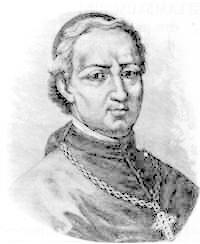
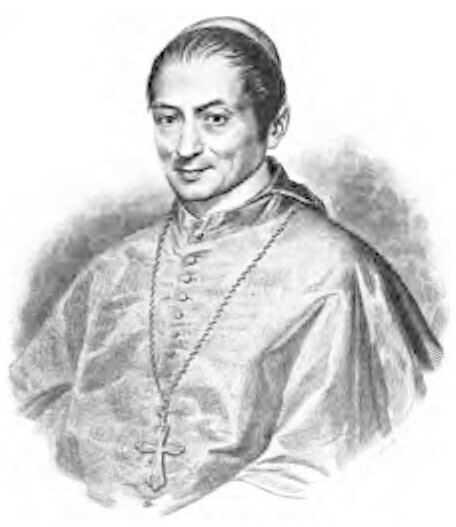
Cardinal Lambruschini Cardinal Gizzi
Conclave
On Sunday, June 14, the Conclave began (Chigi, p. 177): "Oggi è seguito l' ingresso dei Cardinali in Conclave, ed il S. Collegio è venuto processionalmente nelle consuete forme da S. Silvestro al palazzo Quirinale, ma colla pioggia. Il Conclavo non si è chiuso questa sera per non essere assicurata in qualche parte la clausura, e quest' atto è stato differito a dommatina. As the cardinals arrived at the Quirinale Palace they were met by several of the infirm cardinals who had not taken part in the procession: Micara (the Dean of the Sacred College), Alberghini, Polidori, Gizzi, and Bernetti.
The Conclave of 1846 was a very short one, lasting only two days. There was a certain urgent quality to the proceedings, since the Italian cardinals dreaded the application of Austrian influence upon the election (in the form of an exclusiva against Cardinal Mastai-Ferretti), and the Austrian agent, Cardinal Gaisrück of Milan, had not yet arrived in Rome. (This story, which lacks documentary proof, is rejected by De Cesare, Dal conclave, xxxvi-xxxvii.) This sentiment against Austria was being urged on by the French Ambassador, Counte Pellegrino Rossi, who was later (September 16, 1848) Pius IX's first minister. Pellegrino himself was contemplating an exclusiva against Lambruschini.
Balloting
On the first ballot (according to Legge, pp. 41-42), Cardinal Lambruschini, the Austrian candidate, had 32 votes, Cardinal Mastai-Ferretti received 16 votes, and Cardinal Mai 6 votes. Ceccaroni, however, states (p. 34) that Cardinal Mastai, who was the third scrutator, read out 15 votes for Lambruschini and thirteen for himself. This is more likely. Nonetheless, the statement persists that Lambruschini had a majority of the votes on the first ballot, even though the fact was that he was the most hated man in Italy. Popular sentiment, according to Prince Chigi, was entirely of the opinion that Cardinal Tommaso Gizzi, the Apostolic Legate of Forli, would be elected.
On the second ballot, according to Legge, Mastai is said to have received 42, Lambruschini 6, and Mai 2. But Ceccaroni has it that Mastai's total on the second ballot rose to seventeen. But all those statements were in the nature of campaign propaganda, outside conclave and among supporters of various interests, rather than statements of facts.
According to Goddes de Liancourt and Brennan, with whom Ceccaroni is in agreement, the first ballot on the monring of June 15 gave Lambruschini 15 votes and Mastai-Feretti 13; in the evening scrutiny Lambruschini fell to 13 and Mastai-Ferretti obtained 17; on the morning of June 16, Lambruschini fell to 11 votes, and Mastai-Ferretti rose to 27; in the evening, Lambruschini obtained only 10, while Mastai-Ferretti received 36. Giovanni Cardinal Mastai-Ferretti, the Bishop of Imola, was elected on the fourth ballot, (taking the name Pius IX), with 36 of the 50 votes (according to Chigi, p. 178; Johnson says 37), in the belief that he was a "moderate progressive," an appraisal which events would demonstrate within two years to have been quite mistaken. Pius IX was crowned on the balcony of St. Peter's Basilica on June 21, 1846, by Tommaso Cardinal Riario-Sforza, the Cardinal Protodeacon.
Aftermath
On August 8, Pius appointed Pasquale Cardinal Gizzi, who had a reputation as a moderate, to be his Secretary of State (a biographical notice in L' ami de la réligion 30 [1846] 631-632). On October 3, the Pope agreed to establish a commission for better administration, and he established a Council of Ministers. On November 9, Pius IX took possession of his Cathedral Church, the Lateran Basilica; this was the last such elaborate public procession and ceremonial.
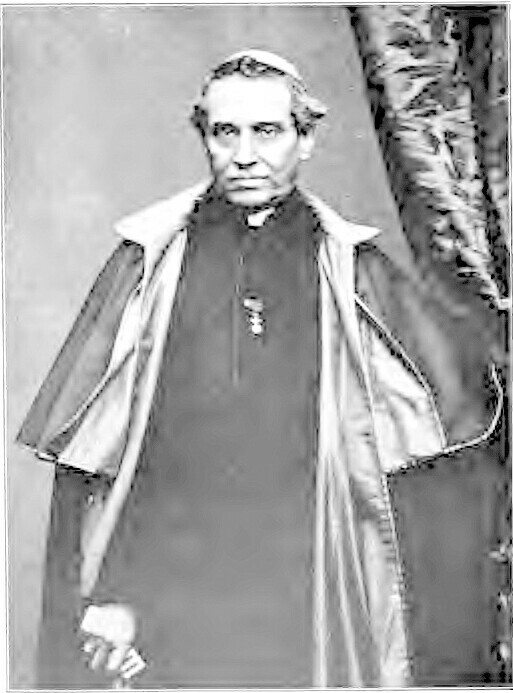
A political censorship was established on March 15, 1847, by order of Cardinal Gizzi. On June 12, a Council of Ministers was actually established, with Cardinal Gizzi at its head, but Gizzi was forced out of office in July (5th or 17th), replaced by the Pope's cousin, Cardinal Ferretti. On July 19 and 20 there were vigorous demonstrations in the city of Rome against its governor, Monsignor Gaspare Grassellini (Cardinal from 1856-1875). On September 7th and 8th, anti-Austrian demonstrations took place. In November, Cardinal Giacomo Antonelli [photo at right], the former Treasurer of the Apostolic Chamber (Ministry of Finance), was appointed president of the Consulta di Stato by the Pope.
On March 14, 1848, Pius issued a Fundamental Statute for the Papal States (Johnston, Theocracy, 345-355). though this granted only limited local self-government and fell far short of the idea of a Constitution. On March 21, the news of the revolt against the Emperor and Metternich in Vienna reached Rome. The 'Circolo Romano', founded in the previous year, invited the Pope to assume the leadership of Italy against Austrian occupation. On April 4, the Pope officially announced his disapproval of the revolution in Bologna against the Austrians. On May 1, Pius refused another invitation from the 'Circolo Romano' and declined to support the liberation from Austria (Risorgimento). Count Rossi, the Interior Minister, was assassinated on November 15, 1848, and the Pope was expelled from his throne and his state. On the advice of Cardinal Antonelli, he fled to Gaeta, in Neapolitan territory.
A Constituent Assembly met in Rome on February 5, 1849, and on the evening of the 8th it was solemnly decreed that the temporal sovereignty of the pope should cease, on the grounds that the Pope had fled and deserted his subjects. Rome was a Republic from February 9, 1849 until April 12, 1850 (coins of the Roman Republic were issued). After his 'restoration', the Pope was able to resist Italian unification only with the support of French troops; in 1860 the Papal States were annexed to the Kingdom of Italy, in 1870 Rome itself.
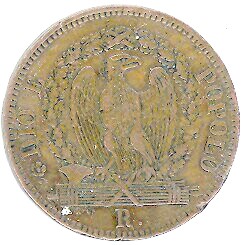 |
AE
|
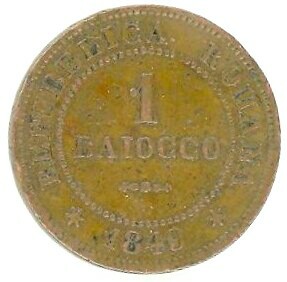 |
(legend, surrounded by band of dots inside and outside:) REPUBBLICA ROMANA •1849 • (in field:) 1 BAIOCCO Berman, p. 210 #3301. O.P.Eklund, "The Copper Coinage of the Papal States" p. 37 #999. |
Bibliography
Descrizione veridica.del Conclave e delle Cerimonie che si praticano in Roma per la elezione del Romano pontefice, aggiuntavi una lettera curiosissima di Dionigi Atangi (Milano; Angelo Bonfanti 1846). An account of the Conclave, in the context of the problems of the time, is provided by R. M. Johnson, The Roman Theocracy and the Republic, 1846-1849 (London: Macmillan 1901), 29-37. Agostino Ceccaroni Il conclave (Torino-Roma 1901) 31-36. See: F. Petruccelli della Gattina, Histoire diplomatique des conclaves Volume 4 (Paris: 1866) 423-462. A. Mills, The Life of Pope Pius IX Volume I (London 1877) 26-30. Alfred Owen Legge, Pius IX. The Story of his Life to the Restoration in 1850 Volume I (London 1875), 41-50. R. De Cesare , Dal conclave di Leone XIII al ultimo consistoro (studi, ricordi e documenti) (Città di Castello: S. Lapi 1899). Friedrich Engel-Janosi, Osterreich und der Vatikan 1846-1919 Erster Band (Graz-Wien-Koln 1958) 4-19.
An account of the Coronation, with the names of the principal participants, can be found in: Adrien Le Clerc's, L' ami de la réligion Volume 30 (1846) 25-29. Arcieri, Relazione della Cavalcata di N. S. P. Pio IX nel solenne possessio della Basilica Lateran. (Roma 1846); Agostino Ceccaroni, Il conclave (Torino-Roma 1901) 177-180 [the Lateran possessio]. Giornale della sede vacante, in cui si da distinta notizia di tutte le funzioni si sagre ... della morte del sommo pontefice, sino all' elezione del successore (Roma: A. Ajani 1846) [non vidi].
Eugenio Cipolletta, Memorie politiche sui conclavi da Pio VII a Pio IX (Milano 1863) 223-240. Count C. A. de Goddes de Liancourt and James A. Manning, Pius IX, or the First Year of His Pontificate (London 1847), 124-126. Nicomede Bianchi, Storia documentata della Diplomazia Europea in Italia Volume V (Torino-Napoli 1869), 5-9. Richard Brennan, A Popular Life of Our Holy Father Pope Pius the Ninth (NY 1877) 77-78. Charles Sylvain, Histoire de Pie IX (Lille 1878). Owen Chadwick, A History of the Popes, 1830-1914 (2003) p. 63. On the republican side, Francesco Petruccelli de la Gattina, Rome and the Papacy (Philadelphia 1872), especially 193-217 (derived in part from Cardinal Micara, according to Petruccelli's claim). R. M. Johnston, The Roman Theocracy and the Republic (London 1901).
Niccolò Marini, Pietro Cardinal Marini, 1794-1863 (Roma: Salviucci 1902).